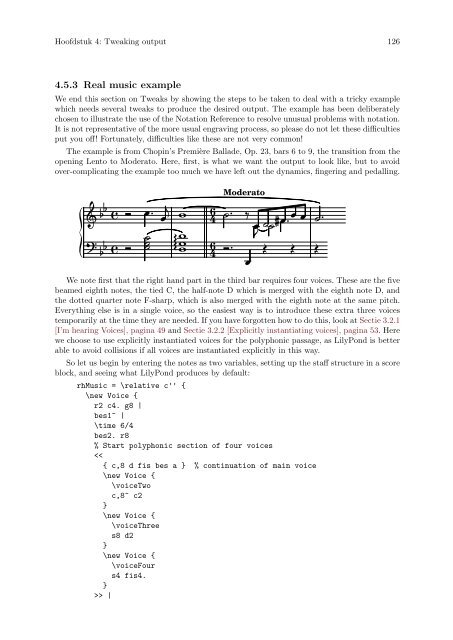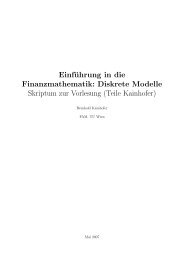LilyPond Beginnershandleiding
LilyPond Beginnershandleiding
LilyPond Beginnershandleiding
You also want an ePaper? Increase the reach of your titles
YUMPU automatically turns print PDFs into web optimized ePapers that Google loves.
Hoofdstuk 4: Tweaking output 126<br />
4.5.3 Real music example<br />
We end this section on Tweaks by showing the steps to be taken to deal with a tricky example<br />
which needs several tweaks to produce the desired output. The example has been deliberately<br />
chosen to illustrate the use of the Notation Reference to resolve unusual problems with notation.<br />
It is not representative of the more usual engraving process, so please do not let these difficulties<br />
put you off! Fortunately, difficulties like these are not very common!<br />
The example is from Chopin’s Première Ballade, Op. 23, bars 6 to 9, the transition from the<br />
opening Lento to Moderato. Here, first, is what we want the output to look like, but to avoid<br />
over-complicating the example too much we have left out the dynamics, fingering and pedalling.<br />
<br />
<br />
<br />
<br />
<br />
<br />
<br />
<br />
<br />
<br />
<br />
<br />
4 6<br />
4 6<br />
Moderato<br />
<br />
<br />
<br />
<br />
<br />
We note first that the right hand part in the third bar requires four voices. These are the five<br />
beamed eighth notes, the tied C, the half-note D which is merged with the eighth note D, and<br />
the dotted quarter note F-sharp, which is also merged with the eighth note at the same pitch.<br />
Everything else is in a single voice, so the easiest way is to introduce these extra three voices<br />
temporarily at the time they are needed. If you have forgotten how to do this, look at Sectie 3.2.1<br />
[I’m hearing Voices], pagina 49 and Sectie 3.2.2 [Explicitly instantiating voices], pagina 53. Here<br />
we choose to use explicitly instantiated voices for the polyphonic passage, as <strong>LilyPond</strong> is better<br />
able to avoid collisions if all voices are instantiated explicitly in this way.<br />
So let us begin by entering the notes as two variables, setting up the staff structure in a score<br />
block, and seeing what <strong>LilyPond</strong> produces by default:<br />
rhMusic = \relative c'' {<br />
\new Voice {<br />
r2 c4. g8 |<br />
bes1~ |<br />
\time 6/4<br />
bes2. r8<br />
% Start polyphonic section of four voices<br />
> |



